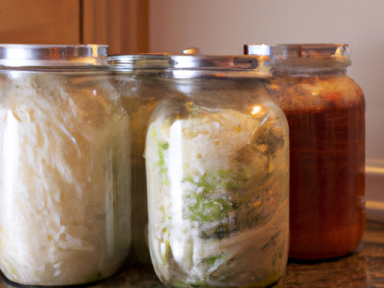
Fermentation Basics: Preserving Food and Promoting Health
In today’s fast-paced and uncertain world, self-reliance is more important than ever. One aspect of self-reliance that often goes overlooked is the art of fermentation. While it may sound like an intimidating or old-fashioned process, fermentation is actually a simple and highly beneficial skill to have. Not only does it allow you to preserve food without electricity or refrigeration, but it also enhances the nutritional value of your food and supports gut health. In this article, we will explore the basics of fermentation and how it can be a valuable tool in your self-reliance journey.
The Importance of Food Preservation
Food preservation is a critical aspect of being self-reliant. When disaster strikes or access to fresh food becomes limited, having a stockpile of preserved food can be a lifesaver. Canned goods and freeze-dried meals are common options, but they often lack the nutritional quality and flavor of fresh food. This is where fermentation comes in.
Fermentation is a natural process that has been used for centuries to preserve food. By harnessing the power of beneficial bacteria, yeast, and other microorganisms, fermentation not only extends the shelf life of food but also enhances its nutritional profile. It allows you to store food for longer periods without sacrificing taste or health benefits.
The Basics of Fermentation
So, how does fermentation work? At its core, fermentation is a process in which microorganisms convert sugars into acids, gases, or alcohol. This conversion process not only creates a tangy or effervescent taste but also produces beneficial compounds like probiotics, enzymes, and vitamins.
There are several different types of fermentation, but two of the most common methods are lactic acid fermentation and alcoholic fermentation.
Lactic Acid Fermentation
Lactic acid fermentation is the process behind popular fermented foods like sauerkraut, kimchi, and yogurt. In this method, lactic acid bacteria convert sugars into lactic acid, creating an acidic and tangy environment that inhibits the growth of harmful bacteria.
To begin the lactic acid fermentation process, the food (such as cabbage for sauerkraut) is mixed with salt and left to sit at room temperature for a period of time. This allows the naturally occurring bacteria to flourish and kick-start the fermentation process. Over time, the food develops its characteristic tangy flavor and becomes a nutritious, probiotic-rich delicacy that can be enjoyed for months.
Alcoholic Fermentation
Alcoholic fermentation, as the name suggests, involves the conversion of sugars into alcohol by yeast or other fungi. This method is commonly used in the production of alcoholic beverages such as beer, wine, and mead.
During alcoholic fermentation, yeast consumes the sugars in the food or beverage and produces alcohol as a byproduct. The fermentation process can be controlled to create various levels of alcohol content, flavors, and aromas, resulting in a wide range of delicious and unique beverages.
The Health Benefits of Fermented Foods
Aside from their preservation benefits, fermented foods are also incredibly beneficial for our health. They are rich in probiotics, which are live bacteria and yeasts that are good for our digestive system. Probiotics help maintain a healthy balance of gut flora, which plays an essential role in digestion, nutrient absorption, and overall immune function.
Consuming fermented foods on a regular basis can improve digestion, promote a healthy immune system, and even support mental well-being. Additionally, fermentation breaks down certain components of food that are difficult to digest, making the nutrients more bioavailable and easier for our bodies to absorb.
Getting Started with Fermentation
Now that you understand the basics of fermentation and its many benefits, you’re probably eager to give it a try. The good news is that getting started with fermentation is relatively simple.
- Choose your fermenting vessel: Depending on what you want to ferment, you can use a glass jar, crock, or fermentation-specific container.
- Select your ingredients: Whether it’s vegetables, fruits, or dairy, choose fresh and high-quality ingredients for the best results.
- Add salt or a starter culture: For lactic acid fermentation, salt is typically added to create the right environment for the beneficial bacteria to thrive. Alternatively, you can use a starter culture that contains the desired bacteria strains.
- Let it ferment: Cover your fermenting vessel to keep out contaminants, but allow gases to escape. Store it at room temperature or in a cool, dark place for the designated fermentation time.
- Enjoy your creations: Once the fermentation process is complete, taste your fermented food to ensure it has reached the desired flavor and texture. Transfer it to a storage container and refrigerate to slow down the fermentation and prolong its shelf life.
Remember, fermentation is both an art and a science, and experimentation is key. Don’t be afraid to try new ingredients, flavors, and techniques. The more you practice, the better you will become at producing delicious and nourishing fermented foods.
Conclusion
Fermentation is a valuable skill to have in your self-reliance toolkit. It allows you to preserve food for extended periods, enhances its nutritional value, and promotes gut health. By incorporating fermented foods into your diet, you can strengthen your immune system, improve digestion, and boost your overall well-being.
So, why not take the leap and embark on your fermentation journey today? Start small with a batch of sauerkraut or kombucha, and watch as your self-reliance and health flourish.



GIPHY App Key not set. Please check settings